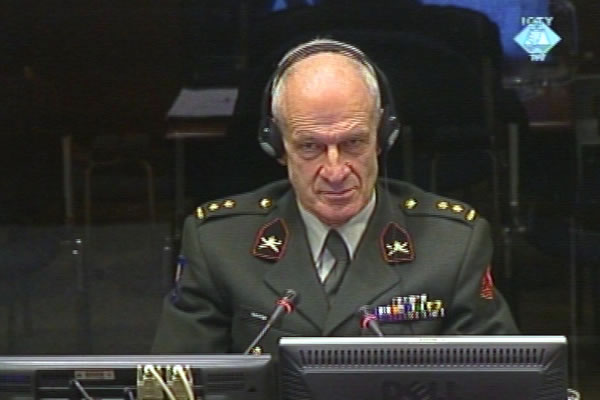Home
PANIC AMONG SOLDIERS OR CIVILIANS?
Gotovina's defense counsel has tried to prove that Knin and other Krajina towns were shelled in Operation Storm in order to cut off the communications between Serb units and to spread panic among soldiers, not civilians. Dutch lieutenant colonel Harry Konings has not denied this claim; however, he has repeated his conclusion that the military targets in Knin were not worth causing panic among civilians and risking civilian casualties
 Harry Konings, svjedok na suđenju Gotovini, Čermaku i Markaču
Harry Konings, svjedok na suđenju Gotovini, Čermaku i Markaču As the cross-examination of the prosecution expert Harry Konings continued, Ante Gotovina’s defense counsel tried to prove that the shelling of Knin on 4 and 5 August 1995, during Operation Storm, was aimed at causing panic among SVK troops and not among civilians. In his expert report drafted for the trial of generals Gotovina, Cermak and Markac, the Dutch lieutenant colonel concluded that the purpose of the artillery attack was to spread panic among civilians and thus to force the army to surrender and flee.
Defense counsel Kehoe showed the witness some biographies and statements given by former high-ranking officers of the SVK they wrote or gave after the war, where they accused each other of treason and identified fear and panic as the main reasons for feeble resistance offered to the Croatian troops in August 1995. When the witness was asked if he agreed that causing panic among Serb soldiers were a legitimate goal of an artillery attack, Lieutenant Colonel Konings said that ‘generally speaking it would be so’; nevertheless, the same panic was spread among civilians too.
According to Gotovina’s defense, the other reason why Knin was shelled was to prevent the movement and mutual contact of Serb units in the town. This argument was corroborated by quotes from the books high-ranking Serb officers wrote after leaving Krajina. Former artillery commander, General Vrcelja stated in his book War for Serb Krajina that on 4 August 1995 the soldiers were afraid to go from the barracks to the Main Staff building. The witness again agreed ‘in principle’ with Kehoe’s argument noting that cutting off the communications between enemy officers and units could be a purpose of the artillery attack. However, the information from the field he received from the prosecution didn’t lead him to conclude that there were any major defense facilities in Knin in early August. Therefore, severing communications between them was not reason enough for the artillery to shell military targets in civilian areas.
As the cross-examination continued, the defense counsel criticized the Dutch lieutenant-colonel for not dealing in greater detail with the disposition and movements of the Croatian units during Operation Storm. The witness replied that he had ‘a general picture’ which was sufficient for his analysis of the artillery attacks.
Harry Konings’s evidence continues on Monday.
Linked Reports
- Case : Gotovina et al. - "Operation Storm"
- 2009-01-15 AMERICAN LAWS FOR GOTOVINA'S DEFENSE
- 2009-01-14 WITNESS: 'KNIN WAS LIKE SARAJEVO'
- 2009-01-13 CIVILIANS OR SOLDIERS IN CIVILIAN CLOTHES?
- 2009-01-19 BEST OR WORST TACTICS USED IN KNIN ATTACK?
- 2009-01-20 GENERAL GOTOVINA ISSUED ‘VAGUE’ ORDER
- 2009-01-22 DANISH OBSERVER: OBJECTIVE OF OPERATION STORM WAS KRAJINA WITHOUT SERBS
